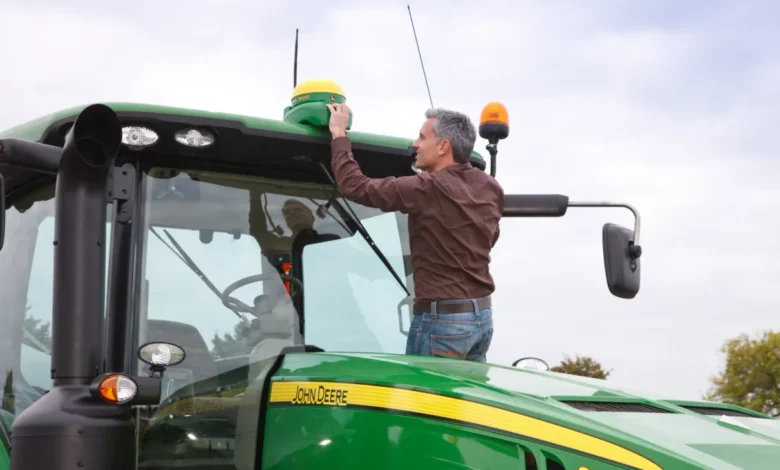Solar Storm Knocks Out Farmers’ Tractor GPS Systems During Peak Planting Season

Subscribe
Join the newsletter to get the latest updates.
🖥️
404 Media is a journalist-owned website that is written by real people for real people. Sign up to support independent journalism.
The solar storm that brought the aurora borealis to large parts of the United States this weekend also broke critical GPS and precision farming functionality in tractors and agricultural equipment during a critical point of the planting season, 404 Media has learned. These outages caused many farmers to fully stop their planting operations for the moment.
One chain of John Deere dealerships warned farmers that the accuracy of some of the systems used by tractors are “extremely compromised,” and that farmers who planted crops during periods of inaccuracy are going to face problems when they go to harvest, according to text messages obtained by 404 Media and an update posted by the dealership. The outages highlight how vulnerable modern tractors are to satellite disruptions, which experts have been warning about for years.
“All the tractors are sitting at the ends of the field right now shut down because of the solar storm,” Kevin Kenney, a farmer in Nebraska, told me. “No GPS. We’re right in the middle of corn planting. I’ll bet the commodity markets spike Monday.”
Specifically, some GPS systems were temporarily knocked offline. This caused intermittent connections and accuracy problems with “Real-Time Kinematic” (RTK) systems, which connect to John Deere “StarFire” receivers that are in modern tractors and agricultural equipment. RTK systems use GPS plus a stream of constantly-updating “correction” data from a fixed point on the ground to achieve centimeter-level positional accuracy for planting crops, tilling fields, spraying fertilizer and herbicide, etc.
According to updates from Landmark Implement, which owns John Deere dealerships in Kansas and Nebraska, the solar storm ruined the accuracy of RTK systems for many farmers using John Deere tractors. Similar systems in other brands of tractors have also been compromised, the dealer and farmers I spoke to said.
“Due to the way the RTK network works, the base stations were sending out corrections that have been affected by the geomagnetic storm and were causing drastic shifts in the field and even some heading changes that were drastic,” the dealership told farmers Saturday morning. “When you head back into these fields to side dress, spray, cultivate, harvest, etc. over the next several months, we expect that the rows won’t be where the AutoPath lines think they are. This will only affect the fields that are planted during times of reduced accuracy. It is most likely going to be difficult—if not impossible—to make AutoPath work in these fields as the inaccuracy is most likely inconsistent.”
🚜
Has your farm been affected by the solar storm? I would love to hear from you. Using a non-work device, you can message me securely on Signal at +1 202 505 1702. Otherwise, send me an email at [email protected].
These automated systems have become critical to modern farming (often called “precision agriculture”), with farmers using increasingly automated tractors to plant crops in perfectly straight lines with uniform spacing. Precision agriculture has greatly increased the yield of farms, and a 2023 report by the US Department of Agriculture noted that more than 50 percent of corn, cotton, rice, sorghum, soybeans, and winter wheat are planted and harvested with “automated guidance.” Many modern tractors essentially steer themselves, with the oversight of a farmer in the cab. If the planting or harvesting is even slightly off, the tractors or harvesters could damage crops or plant crooked or inconsistently, which can cause problems during the growing season and ultimately reduce yield.
Landmark Implement first warned farmers about the problems Friday in a text message blast obtained by 404 Media: “Please be advised that there is a significant solar flare and space weather activity currently affecting GPS and RTK networks. This severe geomagnetic storm is the worst since 2005 and is forecasted to continue throughout the weekend.” That message advised farmers to shut down their reliance on the networks entirely.
The National Oceanic and Atmospheric Administration (NOAA) said that what’s happening is the “most extreme geomagnetic storm since 2003,” and that “there have been preliminary reports of power grid irregularities, degradation to high-frequency communications, GPS, and possibly satellite navigation.” NOAA said the storm will continue into Monday. Geomagnetic storms happen when there is a coronal mass ejection from the sun, which is an eruption of electromagnetic radiation that can impact GPS, the electric grid, and other communications.
Farmers and experts I spoke to told me that GPS outages in farming are a very big deal. Landmark Implement has not given any further updates to farmers, and John Deere did not respond to a request for comment. Farmers I spoke to seem to think that the situation is getting better, but solar storms are expected to continue hitting Earth over the next day or so.
“In the corn belt, May 15 is a critical date to get corn planted,” Willie Cade of Repair.org, who has been working to pass legislation that would make tractors more repairable, told me. “But you don’t want to go out there with your equipment right now. Oh my God, the corn belt can’t get its corn in the ground by May 15? It’s huge. I’m thinking it’s going to go away, but if it doesn’t, shit.”
Tom Schwarz, who owns an organic farm in Nebraska, told me he had to stop planting on Friday and Saturday because of the issue, and said that the outage, combined with a bad weather forecast in the next few days, is threatening the small time window that he has to plant corn.
“When you have your window, you have to go,” Schwarz said. “We’ve just had two beautiful days from a weather perspective of being able to plant and you know, we just have to sit here. We’re not getting anything done, and it’s driving everyone nuts.”
Schwarz says organic farms like his rely heavily on precision farming features, because rows of crops are planted very tightly together to prevent weeds from growing in the spaces between plants. “We used to have markers that would scratch a line in the ground that you could then use to kind of drive by eye,” he said. “Now, we plant so tight in terms of how much the tractor can go side to side and how much the equipment can go side to side that if we aren’t absolutely perfect, it just doesn’t work. You just physically can’t drive that straight [without guidance]. If you’re sitting up there in a tractor seat, you can’t steer fast enough or well enough to not kill the crop because we’re so tight on clearances.”
The fact that this happened also highlights how vulnerable modern food supplies are to GPS outages. Modern society as a whole is obviously very reliant on GPS, but experts have warned that tractors that rely on internet connections and on satellites are a particularly concerning attack vector.
Last year, an outage with Inmarsat satellites caused tractors in Australia and New Zealand to “grind to a halt,” and the remote bricking of connected tractors in Ukraine in 2022 showed a type of vulnerability many hadn’t considered before. Experts have warned about the possibility of a cyber attack targeting tractors or the satellites they rely on as a major threat to our food supply.
Farmers in online communities all over the internet have been discussing the GPS outages, with some saying that they’ve been running into “very weird issues.” One farmer in Manitoba posted “Yesterday was a shit show. Going to be some stripes in the fields. Today it’s back to normal.” I also messaged with two people who work on separate farms and posted in a Reddit thread called “Anyone else lose GPS right now?” I agreed not to use their names because they do not own the farms and were not authorized to speak to the press.
One of them, in southern Ontario, said that they use a positioning system called TopCon, which normally offers “sub-inch accuracy,” they said. “Yesterday I saw issues I’ve never seen before. The really puzzling part was when it was actually seeing enough satellites to function from time to time it was wandering off position by 3 or even 6 feet at times! And I know that the system thought it was on target because the coverage map on the monitor in the tractor was showing that I was exactly on the row, but physically I was off by a huge amount.”
The other farmer from Reddit told me that they were in the middle of planting wheat when problems arose. “We didn’t shut down, we just carried on and however it went in is how it went in lol,” they said. “I probably take the most pride in my work of those on this farm so the boss said I had to lower my standards of quality for the sake of getting the crop in. It wasn’t the common problem of the lines just not matching up, the GPS shading thought it was spot on to where it should be but a lot of the time it either left a gap or overlapped by as much as a few feet. It wasn’t even uniform enough that I could recenter the tractor.”
About the author
Jason is a cofounder of 404 Media. He was previously the editor-in-chief of Motherboard. He loves the Freedom of Information Act and surfing.




